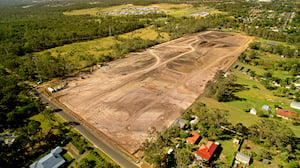3 Real Estate Development Strategies to Consider in 2024
Real estate is a localized asset. Its value is influenced by things like tax rates, the local business climate, government regulations, demographics, nearby amenities, and the cost of living.
But in addition to local forces, it's critical to also consider the macroeconomic landscape when making real estate decisions.
The macroeconomic trends we're seeing today are conducive to several unique real estate development strategies in 2024.
Guide to the video
- As an asset class, real estate is facing significant headwinds. But, market challenges create inefficiencies and opportunities for development
- Missing middle infill development is an efficient solution to housing supply challenges
- Small business owner-occupants are generally more resistant to interest rate changes and present a unique opportunity for real estate developers
Video transcript follows
There is a lot of uncertainty surrounding real estate as we head into 2024. The industry is facing serious headwinds, headlined by continued elevated interest rates, large amounts of maturing debt, and stagnating rent growth.
But there are and will be opportunities in land development if you know where to look.
None of these strategies I discuss in this video are groundbreaking concepts. But in the context of the macroeconomic landscape, a presidential election year, and broader real estate pessimism, they offer new ways of solving age old challenges.
So, let’s jump in.
----------
What’s up everyone – it’s Matt Marsh with Marsh & Partners.
Marsh & Partners is a development and national consulting firm that helps business owners and investors maximize their real estate and transform their businesses.
If you’re enjoying what we’re doing here, and want to keep seeing more content like this, please hit that like button and share this video and our other videos with people you think might find some value in them.
The current real estate market backdrop
We exist in a very interesting time in real estate right now. In no particular order, here are some realities of the current market.
The bull run of the last decade and historically low interest rates deluded a lot of investors into thinking they had real estate figured out, because almost everyone in the space made money. But those who bought at the cycle peak now realize that value appreciation isn’t a given.
The recent industry darlings, class A industrial and multifamily properties, are facing major challenges. Too many apartments were sold between 2019 and 2022 at historically low cap rates that buyers could make pencil with aggressive rent growth assumptions. Most principals had a similar playbook - inject some capital into surface-level aesthetic improvements, jack up the rent, plan a refinance at 24-months, and exit after a 3 to 5 year hold with an exit cap rate in the 4's or 5's. And when you’re refinancing or trying to sell in an environment with double the interest rates, that blows a proforma up real quick.
It seems clear that the office market is forever changed. Despite all the chatter around forced return to office policies, occupancy rates seem to have plateaued around 60% and it’s even worse in some markets and across certain types of office properties.
Maturing debt is a big problem. Most commercial loans have short maturity periods and balloon payments where the property needs to be sold or the debt refinanced. When the value of the underlying asset has fallen, a cash-in refinance or equity infusion is normally required. And when the interest rate is double what it was at acquisition, that monthly debt service payment can become crippling. Now, the alternative to refinancing maturing debt is to sell the property; but if the value of the property has fallen due to market conditions, that obviously results in a sale at loss.
Some markets are overbuilt, especially in multifamily. Inefficiency in the land entitlement, permitting and development process means that the new construction pipeline typically lags the market by 18-24 months. The number of new units that have come online in cities like Phoenix, Austin, and Nashville is staggering and aren’t being absorbed well by the market.
Rent growth has stalled across the county for most asset types. To be fair, the growth we saw over the past few years was unsustainable. But when you have a bunch of inexperienced real estate investors, out over their skis, buying properties with other people’s money based on exponential rent growth assumptions you have a recipe for disaster. Developers who were able to finance projects based on projected rent growth in the midst of massive construction cost inflation are also in trouble.
Higher interest rates have forced many would be buyers to the sidelines. Transaction volume slowed substantially to close out 2023, but we are seeing a small uptick as rates have begun to ease slightly. At the same time, there is still quite a bit of available dry powder ready to be deployed - we've only seen the M2, which is a measure of the money supply, shrink by 5% in 18 months since the start of rate hikes.
And lastly, the supply/demand dislocation still exists. There are more prospective homebuyers than there are available properties on the market. A large proportion of home sales are new builds as owners sitting on 3% mortgages don’t want to sell and then be forced to buy in a higher rate environment. That’s why home builders remain bullish, especially in areas with population in-migration growth and positive underlying employment fundamentals.
So, all this provides a backdrop as we explore several develop strategies that may be successful over the next couple of years. None of these market realities are deal killers for a positive future of real estate, but what has been profitable in the past may not be moving forward.
3 real estate development strategies to consider in 2024
Real estate is a localized asset. It’s driven by things like taxes, the local business climate, demographics, education levels, nearby amenities, the cost of living, etc.
But despite its value being determined by local forces, you must also consider the macroeconomic landscape when making real estate decisions. So, while I may live in Raleigh, the strategies I highlight today, I believe will work in markets across the U.S. due to the prevailing market conditions that we’re all dealing with.
You just have to be strategic about where you target the opportunities for each specific strategy in your market.
Let’s discuss.
1. Infill development
Affordable housing is a hot button topic right now. There’s a lot of brainpower being spent on coming up with creative solutions to solve the housing crisis.
As developers and policy makers weigh different solutions, there is a fact that needs to be considered – land in urban areas is more expensive than rural property. Urban land is also less plentiful – so the natural inclination is to look at the periphery of urban areas for available land, which leads to more sprawl as the natural progression of development.
But suburban sprawl often does little to solve housing challenges and typically doesn’t do a good job of supporting those most in needs of housing with proximity to public transportation options and employment opportunities.
Missing middle infill development offers a great alternative to traditional stick-built apartments, which are overbuilt in many markets, and suburban single-family housing.
I love this space for a couple of reasons:
- Infill projects often support development in a walkable context
- These projects avoid further outward sprawl, and you can often cater to the same population that might gravitate toward traditional multifamily product
- Infill development adds to the diversity of housing choices
- Developers/owners can typically drive rental rates beyond what similarly positioned housing alternatives can support
Additionally, many municipalities are in the process of re-writing and in some cases have already re-written their code to allow for more progressive housing options in urban areas. You’re seeing a push for the elimination of single-family zoning to allow for 2-4 unit infill development by-right, a push for ADU’s, and more relaxed exempt plat development.
All these trends are conducive to infill development being great asset class to consider in 2024 and 2025.
2. Build-to-suit (BTS) development
Build-to-suit development has been around forever. It’s essentially the process of a commercial building being custom built for a specific end-user or operating company. The business will then lease the space back from the developer or real estate investor.
For some context, I don’t believe that real estate is the only industry that’s impacted by the current market conditions I talked about earlier in this video. We’ve seen layoffs across tech and financial services, and despite the flawed and misleading employment statistics, businesses are in fact pulling back in preparation for a recession.
But economic uncertainty also forces companies to real evaluate their business and real estate strategies. That could result in the need for facility optimization to complement business operations, space consolidation, or even expansion.
A build to suit alleviates the need for the operating company to come out of pocket with large sums of up-front capital. It allows businesses to more efficiently allocate their dollars towards core income producing business functions instead of tying capital up in real estate.
As a real estate developer, you need to consider whether the business can support the rental rate that’s required to accommodate the cost to deliver the building and an adequate rate of return.
Operating companies aren’t as impacted by interest rates as typical real estate investors. So even if interest rates remain “elevated” through 2024 into 2025, expect that business will still be able to cover rent requirements on a case-by-case basis.
3. Land entitlement
Land entitlement as a real estate investment strategy has gained popularity over the last couple of years. Investors see it as an opportunity to participate in the real estate development process without having to commit the same amount of capital as you normally would during development.
Because it’s a slightly lower barrier to entry activity than a full cycle development project, there aren’t as many low hanging fruit because a larger number of investors are chasing the strategy.
But there are great opportunities if you know where to look. And if you know how to underwrite a project leaving yourself enough meat on the bone to exit at various stages of land entitlement or permitting.
The key to this strategy is being well versed in real estate due diligence, and being well-connected enough with back-end buyers so that you aren’t left holding a property that is overpriced or no one wants to buy.
How you structure your underlying land contract will be critical to the success of this strategy regardless of land exit strategy you’re pursuing. Additionally, there is still a lot of capital sitting on the sideline looking for places to deploy. And most investors don’t have the expertise or the time to try to entitle a property themselves. If you’re crafty, you may be able to structure a deal using investor capital to entitle a project and even complete the horizontal land development before selling the project.
I love coming up with creative land entitlement strategies depending on the kind of property, the area, and project margins. If you want to brainstorm ideas, you can book some time on my calendar to discuss.



